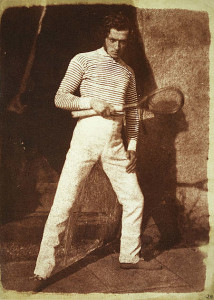- Artists: Robert Adamson & David Octavius Hill
- Title/Subject: Mr Laing or Laine
- Date: 1843
- Collection: National Galleries Scotland
- Acc. No. PGP HA 558
- Medium: Calotype print: “The first effective version of photography, using drawing or writing paper for both the negative and the positive. The paper was sensitised with potassium iodide and silver nitrate, exposed and developed in gallic acid and silver nitrate.”
- Size 19.60 x 14.30 cm
- Credit Provenance unknown
“The identity of the smartly dressed tennis player in this staged scene is uncertain and yet this calotype has become a popular picture postcard. Hill and Adamson are best remembered for the subtlety and perceptiveness of their photographic portraits but at times they showed a keenness for the representation of movement. Here movement is easy to detect in the blur of the racket and the man’s forearm. The player’s intense gaze furthermore suggests that a tennis ball just just gone out of the picture frame.”
For real tennis players, this is obviously a posed photograph and if H&A intended this photograph to demonstrate the backhand or a technical depiction of someone playing the sport, unfortunately Mr Laing/Laine is holding the racquet upside down or incorrectly while his preparation with limp wrist would never withstand the impact of an incoming ball nor did it provide the strength to hold the racquet for the time needed to take the photograph! Mr Laing/Laine looks more like a fencer holding a parry than a tennis player. Given the Adamsons’ (including brother John) connections with Fife and the fact that Falkland Palace is the oldest and only active court in Scotland (at this time), these factors may have interested H&A and led to this depiction of the sport. According to Professor Graham Smith, this photograph was taken in Edinburgh at the H&A studio. Note the summer sunlight producing lovely strong shadows of the man and the racquet. According to Graham Smith this print has been re-touched because there was actually a tripod set up behind the model for support which has been erased on the print. There is another version which clearly shows the tripod behind the model. Due to the long exposure this is the reason for the racquet blurring (not to show movement as the NGS entry suggests) and it is possible H&A also provided a support for the wrist although it is not apparent in the photo. [Article Author: Frederika Adam with additional information provided by Professor Graham Smith, University of Michigan, Ann Arbor & University of St Andrew’s, Scotland]
Robert Adamson (Scottish, 1821 – 1848)
Robert Adamson was one of the first professional photographers, setting up in business in Edinburgh in March 1843. He had aspired to be an engineer but his health was too poor. His brother, John, who was involved in the early experiments with photography in St Andrews, taught him the calotype process. Shortly after opening his studio on Calton Hill, Robert met the painter David Octavius Hill. They worked together for a few weeks on studies for a grand painting of the Free Church of Scotland before entering into partnership to explore the possibilities of photography. Despite Adamson’s early death, the two produced some of the most impressive works taken in the medium and greatly influenced later practice in the art.
David Octavius Hill (Scottish, 1802 – 1870)
A painter and a lithographer by training, David Octavius Hill is best remembered for the beauty of the calotypes he and Robert Adamson produced together. Hill was a sociable and kind-hearted man who did much to support the arts in Scotland and between 1830 and 1836 he was the unpaid Secretary of the newly established Royal Scottish Academy. After Adamson’s death, Hill’s attempt to start a new partnership with the photographer Alexander MacGlashan around 1860 failed. Hill is to this day revered as one of the first in the trade who transformed photography into an art form.
The image details, quoted entry and artists’ biographies have been provided by The National Galleries Scotland. Link to the National Galleries of Scotland website
Link to Falkland Palace – to visit Falkland Palace to play contact: Secretary : Bob Hammond
01337 857098 randbhammond@btinternet.com
Link to Troon Sun Court – Buildings at Risk, Register for Scotland
